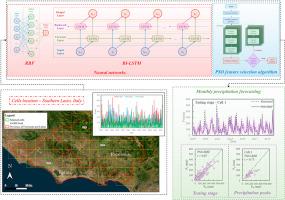Advanced monthly rainfall forecasting in Southern Lazio: Integrating climatic indices, classical or deep neural networks, and a feature selection algorithm
IF 8.7
Q1 Environmental Science
引用次数: 0
Abstract
Accurately predicting monthly precipitation is crucial for managing water resources, particularly in regions with complex climates like Southern Lazio, Italy. This study addresses the challenges of selecting relevant climate parameters and optimizing model complexity for precise forecasting. Four models, based on Bi-directional Long Short-Term Memory (BI-LSTM) and Radial Basis Function (RBF) neural networks, were compared, focusing on their ability to predict monthly precipitation using diverse inputs such as mean temperature, relative humidity, sea level pressure, radiation, precipitation change, and 12 climate indices. One significant challenge was determining the most impactful subset of input variables from a large dataset to enhance model performance without overfitting. To address this, the Particle Swarm Optimization (PSO) feature selection algorithm was employed, significantly improving model accuracy by identifying the optimal subset of input variables. The comparative analysis revealed that PSO-based models consistently outperformed those using all input variables, with the PSO-RBF model achieving a Kling-Gupta Efficiency (KGE) value of up to 0.80 during testing. Notably, both PSO-BI-LSTM and PSO-RBF models demonstrated strong performance in predicting precipitation peaks, achieving KGE values of 0.74. The study highlights the efficacy of the RBF model combined with PSO, which optimizes fewer parameters compared to the more complex BI-LSTM network while reducing input variables. This approach is not only less computationally intensive but also easier to implement, particularly in regions with limited instrumentation. These findings suggest that the PSO-RBF model is a reliable and efficient tool for monthly precipitation prediction in challenging environments.

南拉齐奥月降雨量高级预报:整合气候指数、经典或深度神经网络以及特征选择算法
准确预测月降水量对于水资源管理至关重要,特别是在气候复杂的地区,如意大利的南拉齐奥。该研究解决了选择相关气候参数和优化模型复杂性以实现精确预测的挑战。比较了基于双向长短期记忆(BI-LSTM)和径向基函数(RBF)神经网络的4种模型在平均温度、相对湿度、海平面压力、辐射、降水变化和12个气候指标等不同输入条件下对月降水的预测能力。一个重要的挑战是从大型数据集中确定最具影响力的输入变量子集,以在不过度拟合的情况下提高模型性能。为了解决这个问题,采用粒子群优化(PSO)特征选择算法,通过识别输入变量的最优子集,显著提高了模型的准确性。对比分析显示,基于pso的模型始终优于使用所有输入变量的模型,PSO-RBF模型在测试期间实现了高达0.80的克林-古普塔效率(KGE)值。值得注意的是,PSO-BI-LSTM和PSO-RBF模型对降水峰值的预测效果较好,KGE值为0.74。该研究强调了RBF模型与PSO相结合的有效性,与更复杂的BI-LSTM网络相比,它优化的参数更少,同时减少了输入变量。这种方法不仅计算强度低,而且更容易实现,特别是在仪器有限的地区。这些结果表明,PSO-RBF模式是一个可靠和有效的工具,为逐月降水预测在挑战性的环境。
本文章由计算机程序翻译,如有差异,请以英文原文为准。
求助全文
约1分钟内获得全文
求助全文
来源期刊

Water Cycle
Engineering-Engineering (miscellaneous)
CiteScore
9.20
自引率
0.00%
发文量
20
审稿时长
45 days
 求助内容:
求助内容: 应助结果提醒方式:
应助结果提醒方式:


